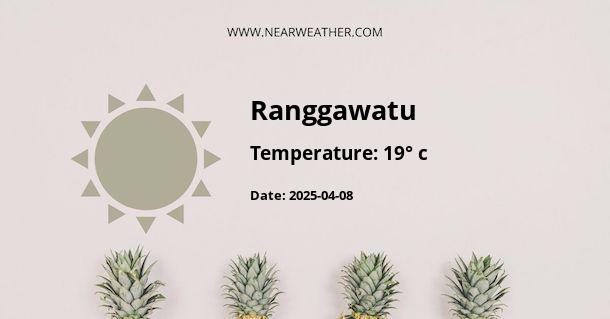Ranggawatu, Indonesia: A Comprehensive Guide to its Climate and Weather Year-Round
Ranggawatu is a picturesque location in Indonesia that is known for its diverse climate and stunning natural beauty. Understanding the weather patterns and climate of Ranggawatu is crucial for anyone planning to visit or live in this area. In this comprehensive guide, we will delve into the climate and weather of Ranggawatu throughout the year, providing valuable insights for travelers, expatriates, and weather enthusiasts.
Climate Overview
Ranggawatu experiences a tropical rainforest climate, also known as an equatorial climate, characterized by high humidity, abundant rainfall, and relatively stable temperatures throughout the year. The region is influenced by its proximity to the equator, which results in consistent warmth and high levels of precipitation.
The climate can be broadly categorized into two main seasons: the wet season and the dry season. Understanding the distinct characteristics of these seasons is essential for gaining a comprehensive understanding of Ranggawatu's climate.
Wet Season
The wet season in Ranggawatu typically spans from November to March. During this period, the region experiences heavy rainfall and increased cloud cover. The wet season is driven by the northeast monsoon, which brings moist air masses from the Pacific Ocean, leading to frequent and intense downpours. This abundance of rainfall contributes to the lush, verdant landscapes that Ranggawatu is renowned for.
It is essential for visitors to be prepared for the wet season by packing appropriate rain gear and planning indoor activities, as outdoor excursions may be disrupted by heavy rain and thunderstorms. Despite the challenges posed by the wet season, many travelers appreciate the vibrant, rain-washed scenery and the opportunity to witness Ranggawatu's natural beauty in full bloom.
Dry Season
The dry season in Ranggawatu typically occurs from April to October. This period is characterized by significantly reduced rainfall and clearer skies. The dry season is influenced by the southeast monsoon, which brings drier air masses, resulting in a decrease in precipitation and an increase in sunshine.
The dry season is an ideal time for outdoor activities, such as hiking, sightseeing, and beach outings, as the weather is generally conducive to exploration and leisure. Travelers can expect warm temperatures and lower humidity during this time, providing a comfortable environment for enjoying the various attractions that Ranggawatu has to offer.
Annual Temperature and Precipitation
Understanding the average temperature and precipitation levels throughout the year is crucial for gaining insight into Ranggawatu's climate. The following table provides a comprehensive overview of the annual temperature and precipitation patterns in Ranggawatu:
| Month | Temperature (°C) | Precipitation (mm) |
|---|---|---|
| January | 27 | 300 |
| February | 27 | 320 |
| March | 28 | 290 |
| April | 28 | 250 |
| May | 28 | 220 |
| June | 27 | 150 |
| July | 27 | 140 |
| August | 27 | 140 |
| September | 27 | 170 |
| October | 27 | 220 |
| November | 27 | 260 |
| December | 27 | 290 |
As depicted in the table, Ranggawatu maintains relatively stable temperatures throughout the year, with average monthly temperatures ranging from 27°C to 28°C. The region experiences the highest precipitation levels during the wet season months of January and February, with an average of 300mm to 320mm of rainfall. Conversely, the dry season months of June, July, and August witness significantly reduced precipitation, with an average of 140mm to 150mm of rainfall.
Extreme Weather Events
Ranggawatu, like many tropical regions, is susceptible to extreme weather events such as tropical cyclones. These intense storms can bring devastating winds and heavy rain, posing significant risks to life and property. Understanding the likelihood and impact of these events is crucial for residents and visitors alike.
It is essential for individuals living in or traveling to Ranggawatu to monitor weather advisories and be prepared to take necessary precautions in the event of a tropical cyclone. Being aware of evacuation routes, securing supplies, and staying informed through reliable sources are fundamental steps for mitigating the risks associated with extreme weather events.
Conclusion
Ranggawatu's climate and weather exhibit characteristic patterns that are influenced by its tropical rainforest climate and proximity to the equator. The interplay of the wet and dry seasons shapes the environmental dynamics of the region, offering unique experiences for those who wish to immerse themselves in its natural splendor. By understanding the climate and weather of Ranggawatu throughout the year, individuals can better prepare for their visit or relocation, allowing them to make the most of what this captivating location has to offer.
Whether it's embracing the lush greenery of the wet season or relishing the outdoor activities during the dry season, Ranggawatu invites travelers and residents to appreciate the diversity and beauty of its climate and weather year-round.
A - Ranggawatu's Latitude is -8.610100 & Longitude is 120.042099.
A - Weather in Ranggawatu is 22° today.
A - Climate Conditions in Ranggawatu shows overcast clouds today.
A - Humidity in Ranggawatu is 93% today.
A - Wind speed in Ranggawatu is 6.59 km/h, flowing at 343° wind direction. today.
